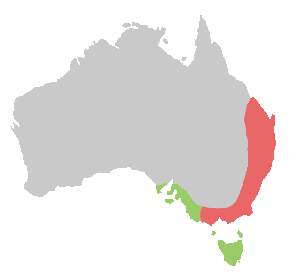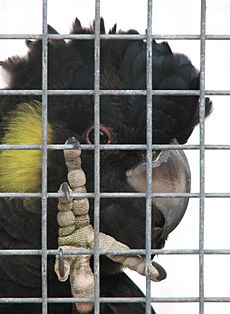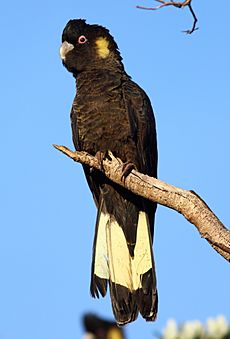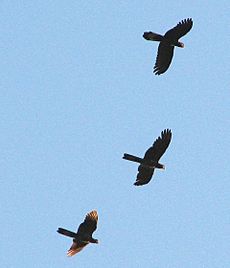Yellow-tailed black cockatoo facts for kids
Quick facts for kids Yellow-tailed black cockatoo |
|
|---|---|
 |
|
| A male in Wamboin, NSW, Australia | |
| Conservation status | |
| Scientific classification | |
| Genus: |
Zanda
|
| Species: |
funerea
|
| Subspecies | |
|
Z. f. funerea |
|
 |
|
| Yellow-tailed black cockatoo range: Z. f. funerea in red Z. f. xanthanota in green |
|
The yellow-tailed black cockatoo (Zanda funerea) is a large cockatoo that lives in southeastern Australia. These birds are about 55–65 cm (22–26 in) long. They have a short crest on their heads.
Their feathers are mostly brownish-black. They have bright yellow patches on their cheeks and a yellow band on their tail. The edges of their body feathers are yellow, making them look like they have a scalloped pattern.
Adult male cockatoos have a black beak and pinkish-red rings around their eyes. Females have a bone-coloured beak and grey eye-rings. When they fly, they flap their wings slowly and deeply. Their loud, wailing calls can be heard from far away.
Yellow-tailed black cockatoos live in forests from central eastern Queensland to southeastern South Australia. A small group also lives on the Eyre Peninsula. There are two main types, called subspecies. Birds from Queensland to eastern Victoria have longer wings and tails. They also have darker feathers. Birds from western Victoria, South Australia, and Tasmania have more yellow scalloping.
Unlike some other cockatoos, these birds eat a lot of wood-boring grubs. They also enjoy seeds. They build their nests in hollows high up in large Eucalyptus trees. Even though they are still common, losing their homes and large nesting trees has caused their numbers to drop in some areas.
However, some yellow-tailed black cockatoos have learned to live near people. You can often see them in cities like Canberra, Sydney, Adelaide, and Melbourne. This bird is protected by CITES, an international agreement that helps keep wild animals safe from illegal trade.
Contents
About the Yellow-tailed Black Cockatoo
The yellow-tailed black cockatoo was first described in 1794. It was named Psittacus funereus because its dark feathers looked like clothes worn for a funeral. Later, it was placed in a new group called Calyptorhynchus.
The official name for this bird is "yellow-tailed black cockatoo." People also call it the yellow-eared black cockatoo or wylah. Wy-la is an old Aboriginal word from the Hunter Region in New South Wales. The Dharawal people from the Illawarra region call it Ngaoaraa.
There are two main groups of black cockatoos. The yellow-tailed cockatoo belongs to the Zanda group, along with two white-tailed species from Western Australia. The other group, Calyptorhynchus, includes the red-tailed black cockatoo and glossy black cockatoo. Birds in the Zanda group look similar whether they are male or female.
There are two recognized types, or subspecies, of the yellow-tailed black cockatoo:
- Z. f. funerea: This is the eastern yellow-tailed black cockatoo. It lives from central Queensland down through New South Wales and into eastern Victoria. These birds are generally larger with longer tails and wings.
- Z. f. xanthanota: This is the southern yellow-tailed black cockatoo. It lives in western Victoria, southeastern South Australia, and Tasmania.
What They Look Like
The yellow-tailed black cockatoo is about 55–65 cm (22–26 in) long and weighs between 750 and 900 grams. It has a short crest on its head that can move. Its feathers are mostly brownish-black. The edges of the feathers on its neck, back, and wings are paler. It has bright yellow bands on its tail feathers.
Males have a black bill and pinkish-red rings around their eyes. Females have grey eye-rings and a horn-coloured bill. Their yellow cheek patches are also brighter. Young birds have duller feathers, a horn-coloured bill, and grey eye-rings. The male's upper beak turns black by two years old.
Their long, pointed upper beak helps them dig out grubs from tree branches and trunks. The yellow-tailed black cockatoo is easy to tell apart from other dark birds because of its yellow tail and ear markings. Its special call also helps identify it.
Where They Live

Yellow-tailed black cockatoos live across southeastern Australia, including Tasmania and islands like King, Flinders, and Cape Barren. In Tasmania, it is the only black cockatoo. On the mainland, they live from Queensland down through New South Wales and Victoria, reaching southeastern South Australia.
A very small group of 30 to 40 birds lives on the Eyre Peninsula. They live in sugar gum woodlands and move to other areas after breeding. These birds are common in many places. However, their breeding areas need large, old trees with hollows.
They can live in many different places, like woodlands, forests along rivers, and even pine plantations. Sometimes, they are seen in cities if there is enough food. For example, they can be found in parts of suburban Sydney, especially near golf courses and parks.
Daily Life and Behavior
Yellow-tailed black cockatoos are active during the day. They are loud and noisy, and you often hear them before you see them. They fly high up, calling to each other. You might see them flying in pairs, or small groups. Outside of breeding season, they can gather in large groups of over a hundred birds.
They are usually shy, but can be less so in cities. They mostly stay in trees. They only come to the ground to check out fallen pine cones or to drink water. Their flight is smooth and looks "lazy," with slow, deep wingbeats.
They sleep in tall Eucalyptus trees that stand out from others. They also rest there during the day to escape the heat. In the evening, they often socialize, preen their feathers, feed their young, and fly around. If the weather is bad, they will go to their roosting spots earlier.
Their usual call is a high-pitched, wailing sound: kee-ow … kee-ow … kee-ow. They make this call while flying or resting, and it can be heard from far away. They also make a harsh screeching sound if they are alarmed. When they are looking for moth larvae, they make a soft, chuckling call. Adult birds are usually quiet when they eat, but young birds make noisy begging calls.
Reproduction
The breeding season changes depending on where they live. It is from April to July in Queensland and October to February in Victoria, South Australia, and Tasmania. During courtship, the male puffs up his crest and spreads his tail feathers to show off his yellow markings. He makes soft growling sounds and bows to the female.
They nest in large, tall tree hollows, usually in Eucalyptus trees. These trees can be alive or dead. They often choose isolated trees so they can fly in and out easily. The same tree might be used for many years. A study found that trees used for nesting were often over 200 years old.
The hollows can be 1 to 2 metres (3.3 to 6.6 ft) deep and 0.25–0.5 metres (9.8–19.7 in) wide. Both the male and female prepare the hollow by scraping off wood shavings to make a soft bed for the eggs. Sometimes, they add gum leaves too.
They lay one or two white, oval-shaped eggs. The female sits on the eggs alone. The male brings her food a few times a day. The second chick usually does not survive. Chicks stay in the nest for about three months after hatching. They stay with their parents until the next breeding season.
Like other cockatoos, these birds live a long time. Some have lived over 40 years in zoos. They seem to start breeding when they are between four and six years old.
What They Eat
Yellow-tailed black cockatoos eat many different foods from various places. This helps them survive even if their habitat changes. They eat seeds from native trees like she-oaks (Allocasuarina and Casuarina), Eucalyptus (including flowers and seeds), Acacia (including tree sap), Banksia (seed pods and seeds), and Hakea species.
They also like pine cones from planted Pinus radiata trees and other introduced trees. On the Eyre Peninsula, they even rely on the introduced Aleppo pine.
These cockatoos love the larvae (grubs) of tree-boring beetles and moths. They look for holes and bite into the wood to find larvae. If they find one, they peel off bark to make a perch. Then, they dig out the larvae that are deep inside the wood.
They have been seen stripping bark from dead trees to eat a white layer of fungi and slime mould growing underneath. After bushfires, they sometimes flock to Banksia cones as they open up. When eating pine cones, they prefer green ones. They nip them off, hold them with one foot, and then carefully lift each part to get the seed. A cockatoo can spend about twenty minutes on one pine cone.
They drink water from various places, like puddles or farm troughs, usually in the morning or late afternoon.
Parasites
A type of feather mite called Psittophagus calyptorhynchi has been found only on the yellow-tailed black cockatoo.
Yellow-tailed Black Cockatoos and People

Yellow-tailed black cockatoos can sometimes damage pine and Eucalyptus plantations. They dig into the wood to find moth larvae, which can weaken the trees. Because of this, they were sometimes shot as pests in New South Wales until the 1940s.
The Shoalhaven City Council in New South Wales promotes the yellow-tailed black cockatoo as their region's bird. In the Jervis Bay area, these birds are often seen eating from Casuarina trees.
Even though the yellow-tailed black cockatoo is listed as "least concern" globally, its numbers are decreasing in Victoria and South Australia. This is because their homes are being broken up, and they are losing the large trees they need for nesting. However, they have become more common near pine plantations. In South Australia, they are listed as "vulnerable." This is due to their decline in the Adelaide and Mount Lofty Ranges, and especially the small group on the Eyre Peninsula.
A program started in 1998 to help these birds. They are fencing off native bushland, planting food plants, watching their breeding, and raising chicks in captivity. Thanks to these efforts, the population on the Eyre Peninsula has grown from a low of 19–21 birds in 1998.
These birds were not often kept in zoos until the late 1950s. Since then, they have become more common, but are still rare outside Australia. Captive yellow-tailed black cockatoos need a large aviary to stay healthy and active.
Images for kids
See also
In Spanish: Cacatúa fúnebre coliamarilla para niños








